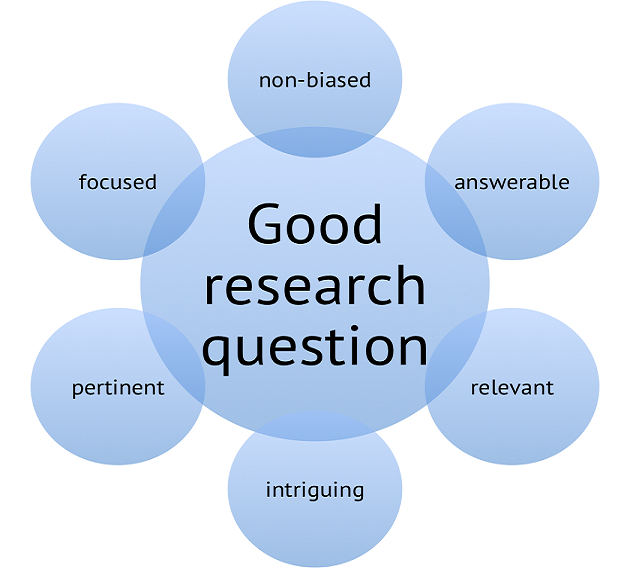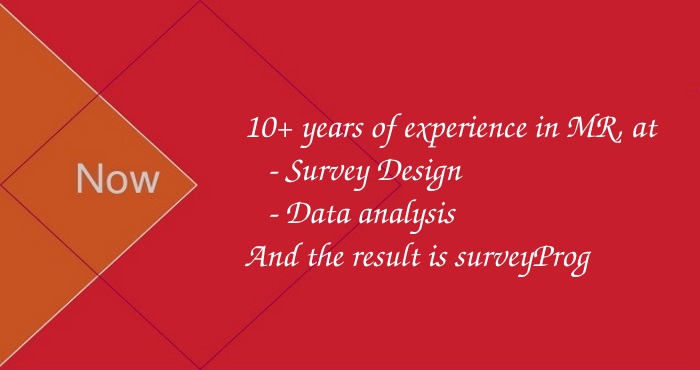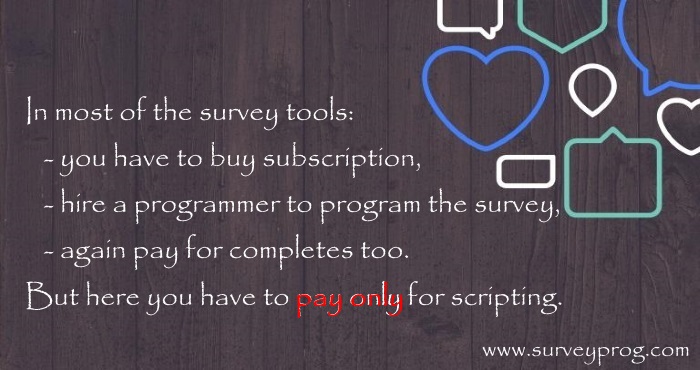SurveyProg Research Solution
Welcome to the blog of survey design

Research questions
We design surveys using our surveyProg tool. April 19, 2018
Keep it as short and simple as possible
A short questionnaire is more likely to be completed and returned. It's important to establish a clear goal for your market research project and avoid including questions that do not contribute to the achievement of this goal.It is also important to make your questionnaire as simple as possible, especially if it is being administered on paper.
Complex designs are generally best suited for online or telephone questionnaires. The software or interviewer can ask the appropriate questions based on previous responses. With paper questionnaires and in-person interviews, however, the use of 'skip patterns' and other potentially confusing design elements should be kept to a minimum.
Keep questions brief and easy to understand
Brief questions that use simple language minimize the chances that your questions will be misunderstood, making your survey results more useful.Simple language is easy to read and comprehend, making your questionnaire less taxing for your participants.
Be brief and direct with your questions, leaving out any unnecessary words and phrases. Short questions are easier for the respondents to answer because they don't have to retain as much information, and therefore are less likely to need to re-read the questions.
Make sure your questions are in the right order
You may want to start your questionnaire with general questions and then move to specific ones. General questions are often easier to answer and can serve as a 'warm-up' that will help your respondents ease into the questionnaire. This can help them to answer more specific questions faster and more accurately later on.Try to avoid jumping back and forth between general and specific questions as this will require your respondents to shift their focus as they attempt to answer the questions. Slowly building up the complexity of the questions can help your respondents maintain concentration for the entire length of the questionnaire. Personal questions, such as those asking for demographic information, should be placed near the end of the questionnaire. This way, you will still have usable data from the questionnaire if the respondent declines to answer the more personal questions. Make sure you respect privacy laws.
Use open-ended questions appropriately
Open-ended questions allow respondents to answer freely using their own words. Closed-ended questions can be answered using a simple piece of information, such as a 'yes' or 'no'.The advantage of open-ended questions is that they can generate more detailed information. However, open-ended questions take more time and effort to answer and can be more difficult to analyze once you have collected your responses.
Avoid using leading questions
A leading question is one in which the answer is suggested within the question itself and can make the respondent feel compelled to answer in a particular way. This can frustrate respondents and skew your survey results.Avoid using compound questions
Compound questions are two or more questions in one. These questions are problematic because the answer may be different for each part of the question.Make sure your questions are straightforward
Ambiguous questions use words that do not have fixed definitions and are therefore open to a range of interpretations by respondents. Questions that use ambiguous words can produce inconsistent results. Avoid being ambiguous about the time period the respondent should consider, and about describing your product or service.Make sure your questions can be answered
Unanswerable questions are those which require the respondent to provide information that is difficult to remember or convey accurately, if at all. If your respondents find the questions too difficult to answer, your response rate is likely to suffer.Future behaviour can be difficult to predict, so while the answers to questions such as ‘If your income increased, would you buy more of product X?' can give you useful information, keep in mind that actual consumer behaviour may unfold differently.
Use clear response scales
Response scales assess a respondent's level of agreement or disagreement with a statement, or their satisfaction with an experience. For example, you might ask a respondent to rate their experience with your business on a scale of one to five.Response scales can be an excellent way to remove ambiguity from questions and gather data that is easy to tabulate and interpret. There are some pitfalls to be aware of, however, when designing questions that incorporate response scales.
Keep it clean and visually appealing
To make your questionnaire as easy to read as possible, keep the following design elements in mind:- Text: Choose a font style that is easy to read, and make sure the font size is large enough for your respondents to read. If you use coloured text, make sure the contrast on the paper or screen is adequate.
- Paragraphs: Long paragraphs can be daunting for readers, so try to keep your blocks of text to a handful of lines.
- White space: Ensure that there is space between questions and sections and don't make margins too small.
Always pre-test your questionnaire
Testing your questionnaire in advance can help you identify any changes that need to be made. There are several testing options you can use.One option is to have friends or family members complete your questionnaire. Try to select people who are unfamiliar with the goals of your market research campaign. Those who already know what information you are looking for may not accurately represent the people who will participate in your survey. Try to select people who won't hesitate to provide constructive criticism if necessary.
One of the best ways to evaluate your questionnaire is to conduct personal interviews or focus groups with individuals that have taken the survey. Getting these individuals to take time to test your questionnaire and give you feedback can be a challenge, so you may want to compensate participants for their time.
The testing method you choose will be influenced by the type of information you require, the amount of time you have available, and your market research budget. Taking the time to develop a well thought-out, participant-friendly questionnaire will give you useful data that can help you make solid business decisions.

Our service
surveyProg superior in survey design for market research that are flexible, robust, dependable and scalable in supporting our clients ever-changing needs in this dynamic arena of market research.

Our Mission
Send survey document to us. We will create a web version, host it and manage it. We also use an array of languages like ConfirmIt, Dimensions and also data analysis with the support of Quantum, IBM SPSS, Tableau and Power BI. The programmers are ready to fulfil the clients requirements 24/7.

About our company
We pride ourselves in providing innovative services in survey program to support our clients with their complex requirements. surveyProg have devised several survey methodologies and system which are applicable as per our clients requisites. More over our surveys are mobile friendly.
Popular Posts
-
 Survey Design
Survey Design
We design surveys using our surveyProg tool. -
 Questionnaire
Questionnaire
Send survey document to us. We will create a web version, host it and manage it. -
 Survey Tool
Survey Tool
Mobile friendly surveys. No charges for completes.
Tags
Survey Design Questionnaire Survey program Survey scripting Online survey Market research Survey tool survey questions survey maker quantitative research qualitative research survey app

